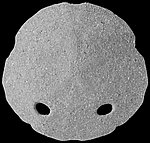Astriclypeidae
Stephanini, 1911, p.747
Genre type : Astriclypeus Verril, 1867
Description succinte de la famille : Test aplati, discoidal, ambitus tranchant. Présence de piliers internes. Apex à 4 gonopores. Présence de deux ou quatre lunules selon le genre.

|
Astriclypeus Mannii Verrill, gen. nov. Ambulacral star as in Encope; four genital openings, the posterior one wanting, as in ilird/ita; with five lunules or perforations in the prolongations of the ambulacra, as in Encope; but destitnte of any perforation or indentation in the posterior interambulacrum, like Lobnpitora. Anal opening round, about midway between the mua and margin. Sulcations of the lower side more simple than in Encope, a primary branch passing along close to the openings, on each side, and sending off numerous inconspicuous branches to the interambulacra. Actinal opening as in Encope. This genus presents a remarkable combination of characters belonging to other allied genera, but lias an assemblage of characters entirely unique. It appears to be most nearly allied to Lobophora, from which it differs chiefly in possessing five ambulacral lunules or openings, instead of but two ; and in the sulcations of the lower surface. |
![]()
|
Astriclypeus Mannii Verrill, sp. nov.* Test subeircular, about as long as broad, with the posterior side slightly truncate, and a slight prominence of the edge opposite each opening. Snmmit central, considerably elevated. Length 4.2; breadth the saine; height •65 ; from center to anterior opening 1•2; to the lateral ones 1•1 ; to end of anterior ambulacral ray 1•2; to lateral '98 ; breadth of anterior ambulacral ray 1•2 ; of its median area •16; of the anterior listerai •45 ; its median area •2; length of three anterior openings •6 ; breadth •18; length of posterior openings •7; breadth .18; center of mouth to anal opening 1 inch ; from the latter to the margin the same. The anterior ray of the ambulacral rosette is a little longer and narrower than the others, with the widest part near the end, which is not closed; lateral rays nearly equal in length, the anterior pair a little vider, increasing in width to near the end, which is broad and rounded. Openings oblong, the posterior pair a little longer. Anal opening nearly circular, midway between the month and margin. |
Locality West Coast of North America (?). (Japan,—Reprint). The single specimen of this curions species was presented by Mr. Horace Mann, of Cambridge, Mass., in honor of whom I have named it. It was obtained by him, with several other West Coast Echinoderms,* from Mr. Pease of the Sandwich Islands. Its origin is entirely doubtful. It is destitute of seines and in the same state of preservation as a Denciraster excentricus, which came with it. * Dr. F. H. Troschel has well descrihed and figured this species under the name of Crustulum gratulans in Niederrh. Gesells. fur Naturg. und Heilkunde, Universitat Bonn, Aug. 3, 1868, p. 1, PI. I. In Archiv fur Naturg. 1869, p. 52, he has identified it with our species and described specimens from Japan (E. von Martens),—Reprint.
|
|
Astriclypeus mannii Verrill,1867 - Pléistocène, Mialoli, Taiwan, 104 mm |

|
Catalogus ectyporum echinodermatum fossilium musei neocomiensis, p.6 Espèce type Scutella bioculata Desmoulins, 1835, par désignation subséquente de Lambert (1907, p.49). Extension stratigraphique (bibliographique, non vérifiée) : Oligocène - Miocène Syn. |
![]()
|
I. Amphiope bioculata Ag. Tab. 11, fig. 1-5. Syn. Scutella bioculata DesMoul. Tabl. syn. p. 232, N°23. Sc. bifora Lam. var. c, Tom. 3, p. 282. - E. Desl. Encycl. Tom. 2, p. 676, N°7. - Encycl. méth. Tab. 147, fig. 5-6. - Desmar. dans Al. Brong. Théor. des terr. Tabl. N° 5, p. 12. Dict. sc. nat. T. 54. Amphiope bioculata Ag. Catal. syst. Ectyp. Mus. Neoc. p. 6. Cette espèce est de forme à peu près circulaire et médiocrement aplatie. Son pourtour ne présente aucune échancrure, mais bien de légères rentrées en face des ambulacres pairs. Le diamètre longitudinal égale à peu près le diamètre transversal. Le côté postérieur est tronqué. Les lunules sont à peu près circulaires ; elles occupent l'espace intermédiaire entre le bord et l'extrémité des pétales postérieurs et autour d'elles, les plaques du test sont disposées en cercle (fig. 1). Les pétales ambulacraires sont courts, mais larges et arrondis à leur extrémité. La fig. 4 représente la rosette apiciale avec l'extrémité des ambulacres sous un faible grossissement. On y distingue les quatre trous oviducaux au sommet des angles du corps madréporiforme, qui correspondent aux aires interambulacraires paires ; l'aire interambulacraire impaire en est dépourvue. Les sillons de la fac inférieure donnent lieu à de nombreuses ramifications, dans lesquelles on distingue, à l'aide d'une forte loupe, des rangées de pores microscopiques. Près de la bouche, là où ils sont encore indivis, ces sillons sont plus profonds et présentent de légères carènes qui sont sans doute |
les tubes dans lesquels étaient logées les branchies buccales. La fig. 5 qui représente la rosette buccale donnera une idée assez claire de cette disposition des tubes branchifères autour de la bouche. L'anus est infra-marginal, mais il ne détermine aucune échancrure dans le bord postérieur. L'Amphiope bioculata provient du terrain tertiaire de France. M. Desmoulins cite comme localité Bordeaux, et Sur près Bollène, département de Vaucluse. Les exemplaires que j'ai sous les yeux m'ont été communiqués, l'un par M. Deshayes, et l'autre par M. Michelin ; ils proviennent de la Touraine. Extrait de la planche 11, fig. 1-5 |
|
Amphiope bioculata (Desmoulins,1835) - Miocène, Désert de Syrte, Libye, 77 mm |
|
Amphiope bioculata (Desmoulins,1835) - Helvétien, Indre & Loire, 72 mm. Spécimen avant dégagement |
|
Amphiope bioculata (Desmoulins,1835) - Helvétien, Indre & Loire, 77 mm |
|
Amphiope cf. bioculata (Desmoulins,1835) - Helvétien, Indre & Loire, 81 mm |
![]()


